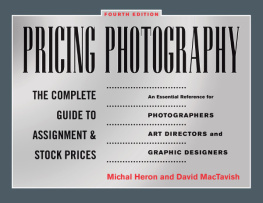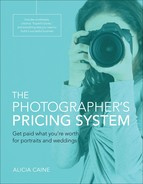Dedication: To Our Families
ACKNOWLEDGMENTS:
The authors wish to express their appreciation to the many ASMP and ASPP colleagues, photographers, legal advisors, and stock agents who have contributed their expertise to this book. In particular gratitude goes to our publisher Tad Crawford for his vision and continuing patience; to Liz Van Hoose for her pleasant manner and her diligent, precise editing; and to Delia Casa for her fine editing and production work and high level of professionalism.
Copyright 1993, 1997, 2002, 2012 by Michal Heron and David MacTavish
All Rights Reserved. Copyright under Berne Copyright Convention, Universal Copyright Convention, and Pan American Copyright Convention. No part of this book may be reproduced, stored in a retrieval system, or transmitted in any form, or by any means, electronic, mechanical, photocopying, recording or otherwise, without the express written consent of the publisher, except in the case of brief excerpts in critical reviews or articles. All inquiries should be addressed to Allworth Press, 307 West 36th Street, 11th Floor, New York, NY 10018.
Allworth Press books may be purchased in bulk at special discounts for sales promotion, corporate gifts, fund-raising, or educational purposes. Special editions can also be created to specifications. For details, contact the Special Sales Department, Allworth Press, 307 West 36th Street, 11th Floor, New York, NY 10018 or info@skyhorsepublishing.com.
15 14 13 12 11 5 4 3 2 1
Published by Allworth Press, an imprint of Skyhorse Publishing, Inc.
307 West 36th Street, 11th Floor, New York, NY 10018.
Allworth Press is a registered trademark of Skyhorse Publishing, Inc., a Delaware corporation.
Cover design by Douglas Design Associates, New York, NY
www.allworth.com
Cover design by Douglas Design Associates, New York, NY
Page composition/typography by SR Desktop Services, Ridge, NY
Library of Congress Cataloging-in-Publication Data is available on file.
ISBN: 978-1-58115-888-5
Printed in the United States of America
Table of Contents
CHAPTER 1
The Business of Photography
P hotography is an obsession, mostly a joyful one. This doesnt have to be explained to any photographer who has felt an adrenaline rush while shooting and deep satisfaction at viewing a finished image. Catching elusive light, graphic details, a fleeting expression, and evocative moments are what draw us to photography.
The profession of photography is unusual in the extraordinary range of abilities it demands of a practitioner. It combines artistic, emotional, and technical skills; it requires you to understand the impact of light on a sensor, to recognize the power of imaging software to enhance photographs, and to have physical, organizational, mental, and emotional strengths as well. You must be at once left- and right-brainedin short, you must do it all.
The joy of photography is in its challenge, adventure, and satisfactions. It is a profession in that it is a way to earn a living; it is also a profession of our faith in the artistic side of our nature. When you fall in love with photography, you are embracing an addictionto the pleasures of creating with light, to a fascination with seeing, and to the delight of sharing the visualization of your emotions and your intellect. Plus, its fun.
Most of us would do photography paid or not. Its part of who we are. Our purpose here is to help you get paid fairly for doing what you love in spite of the special challenges of todays economy.
Make no mistake, its a tough world, and photography is not a sure thing, as veteran photographers know. If you are entering the profession, the silver lining is that new photographers will always be needed, just not as many as in previous years. At the end of this chapter, we consider realistic approaches to building a successful career in the world of photography.
Who is the reader? Are you picking up this book to find prices or, preferably, to learn about negotiating and pricing? Judging by the emails the authors have received over the time span of the three previous editions of this book, readers fall into three general categories: The first is the entry-level photo student struggling to understand how one might earn a living in photography. Second is the working professional who wants to check prices and finetune pricing and negotiating skills to fit the current economy. And third, there is the established veteran, already skilled at negotiating, simply keeping abreast with pricing trends.
Especially for the newcomer, we believe its valuable to understand the evolution of the profession. In this book, well provide information that clarifies traditional concepts of negotiating, as they are the foundations of business. The fundamental principles of negotiating, setting your prices, and maintaining a viable business still hold true, though they have been dramatically altered by the paradigm that came along with the Internet.
Language of negotiation. The traditional concepts of negotiation are meaningful, though the vocabulary may be different. Today, agreements may be expressed in language for Twitter or suitable for texting to a client but must still be backed up by a framework that protects the photographers rights.
If you are coming of age and entering the world of photography as a new professional, you have the advantage of being at ease with all types of instant communication. However, you should not rush headlong into agreements that you dont understand with rights that are not spelled out clearly. Read the chapters on negotiating and translate those precepts into current forms of communication. When you receive a client query, its fine to text or use Twitter to respond with brief bare bones comments that bring you and a client into a working agreement on an assignment. But you should create backup documents to send within hours to nail down details that spell out rights, fees, expenses, and responsibilities.
Using This Book
The temptation to skip the text chapters in this book and go directly to the price charts is understandable. But that would give you numbers without understanding. Unless you are an experienced professional, with a long career of negotiating and pricing, we believe that the information in this revised edition is as relevant as ever in giving you a foundation for understanding how to approach pricing. The doomsayers may argue that negotiating has become a futile exercise since clients are in the drivers seat that they simply offer out their fee and you take it or leave it. Thats only partially true. The fact is that successful negotiations go on regularly. An understanding of negotiating coupled with a clear view of the economics of photography will help you learn whether photography is a viable profession for you.
Earning a Living through Photography
There are many service photography specialties, such as banquet, insurance, or even forensic photography. However, most of the business falls into two general categories: consumer photography and photography for publication.
Consumer-based photography, such as wedding photography and portraiture, provides a product to a retail customer. In this case, the actual product purchased, the photographic print, changes hands and generally is retained by the buyer. Many ancillary photo products are offered, such as a table number photo card, an enlarged album, and DVDs of photos set to music. If a product can be designed with a photo displayed on it, it is probably available from a photographer to a consumer client. But it is a product. Thats the important distinction.
Photography for publication, on the other hand, most often provides a service, not a product. It means that the customer (or final user) is a client who reproduces a photograph in, for example, an advertisement, a calendar, a magazine, an ebook, a website, or a company brochure. In this instance, the photographer allows access to the photograph through the turnover of digital image files with specified usage limitations defined in their paperwork. Most often, the image files are transferred to the client electronically, for example, by posting on an ftp site. Rarely, the image files are burned onto a DVD or CD for shipping to a client. In that case, the only physical property accompanying the disc may be a match print to use for color guidance to a printer or a contact sheet for reference purposes. Its extremely unusual for any tangible item to be provided for reproduction purposes.
Next page








